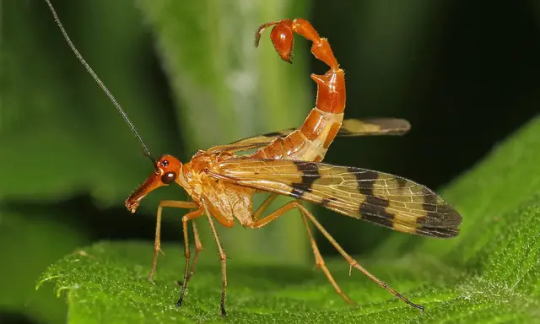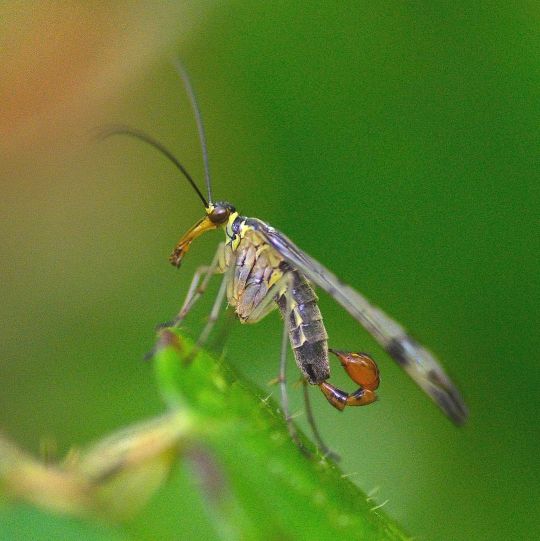#Panorpa communis
Explore tagged Tumblr posts
Text

Scorpion Fly
A scorpion fly resting on a leaf, at Felmersham Gravel Pits.
#bedfordshire#canon#canonuk#fauna#felmersham#felmersham gravel pits#flies#fly#insect#insects#invertebrate#invertebrates#minibeast#minibeasts#nature#nature reserve#outdoors#panorpa communis#scorpion fly#wildlife#wildlife trust#wildlife trusts#wildlifebcn
18 notes
·
View notes
Text
Uncharismatic Fact of the Day
Although scorpionflies may look-- and sound-- scary, they're actually quite harmless! This group of insects is named for their stinger-like appendages that resemble a scorpion's stinger. However, these appendages are actually enlarged genetalia, and are only present on the males of each species.

(Image: A common scorpionfly (Panorpa communis) by Charles Sharp)
Want to request an uncharismatic critter? Just send me proof of donation to any of these vetted fundraisers for Palestinian refugees!
64 notes
·
View notes
Note
🐌 :)

Panorpa communis
37 notes
·
View notes
Text

Panorpa communis, male
11 notes
·
View notes
Text

Mosca scorpione o Panorpa (Panorpa communis Linnaeus, 1758, Panorpidae)
8 notes
·
View notes
Text

file: XN Panorpa communis female 00.jpg
0 notes
Text

Panorpa communis, the common scorpionfly
112 notes
·
View notes
Photo

#original photographers#photographers on tumblr#macro photography#mecoptera#panorpa communis#insects#common scorpionfly#srpice obecná#nenkovice
8 notes
·
View notes
Photo

Photo Series: Nature / Case 25: The Scorpionfly - Panorpa communis
The Scorpionflies (Panorpidae) are a family of Mecoptera. In Central Europe, only five species of the genus Panorpa are found, among them especially common Panorpa communis with a body length of about 18 millimeters.The scorpion flies can be found in shady areas, often on bushes. They feed mainly on dead and injured insects, sometimes also on nectar and fruits. Males of the Scorpionflies have enlarged genitals that look similar to the stingers of scorpions, but they are incapable of stinging, and they do not bite.
Alicja Gacka
Web Developer
www.nolimits-art.com
Hamburg, Germany





#alicja gacka#photographer#web developer#panorpa communis#scorpionfly#mecoptera#insect#nature#macro photography#www.nolimits-art.com
2 notes
·
View notes
Video
Scorpion Fly by Oliver Andrews Via Flickr: A male scorpion fly, showing the (entirely harmless) tail that gets them their name, at Felmersham Gravel Pits.
#bedfordshire#canon#canonuk#felmersham gravel pits#flies#fly#insect#insects#invertebrate#invertebrates#minibeast#minibeasts#nature#nature reserve#outdoors#panorpa communis#scorpion fly#springwatch#wildlife#wildlife trust#wildlife trusts#Bedford#England#United Kingdom#flickr
1 note
·
View note
Photo

#PANORPA COMMUNIS - SCORPION FLY @samirafee
#source: samirafee#own picture#photographers on tumblr#nature#insects#panorpa communis#scorpion fly#july 2017
7 notes
·
View notes
Photo

Scorpionfly (Panorpa communis)
6 notes
·
View notes
Text

Panorpa communis, female.

I found multiple individuals in my garden, all sitting in or around the blackberry bush. All kinds of insects hide and eat in there.
1 note
·
View note
Photo

While hiking through the woods, a female common scorpionfly landed on my friend and I managed to snap a picture of it. It turned out really nice so I decided to post it here. Scorpionflies are among my favourite insekts. They look so cool with their long snoot and thar radical scorpiontail that the males have, which is actually a penislike organ and not a stinger. They are mostly scavengers and use the long mouthparts to eat dead or dying insekts. They have been observed stealing dead insekts from spiderwebs without the spider attacking them and scientists haven't figured out yet how scorpionflies manage to trick the spiders. I remember studying them in college and falling in love with them and now everytime I go for a walk in the woods during summer, I look for them in the untergrowth. We actually found both subspecies native to germany, panorpa communis with the black band on the wings and panorpa germanica with the dotted wings.
3 notes
·
View notes
Photo

Common Scorpionfly (Panorpa communis) - Cullompton Leat Fields, Devon - 18 May 2018 by Dis da fi we Panorpa communis can reach a body length of about 30 millimetres (1.2 in). The common scorpionfly has a black and yellow body, with a reddish head and tail. The male has a pair of claspers at the end of its tail (for holding the female during mating), giving it a scorpion-like appearance, although it is not a stinger. The adult is seen between May and September. [5] They eat dead insects (although they sometimes eat live aphids), sometimes taking them from spider webs[5] and plant sap.[8] Although fully winged, the adults rarely fly very far and spend much of their time crawling on vegetation in damp, shaded places near water and along hedgerows. Panorpa communis is an univoltine species. Eggs are laid in soil annually and the larvae both scavenge and pupate there. https://flic.kr/p/26oTWmw
3 notes
·
View notes
Photo

The scorpion fly (Panorpa communis) looks like an animal from a children’s book, but this insect is not a fictional character! Males are distinguished by their scorpion-like tails, which happens to be their genitalia. During courtship rituals, a suitor will bring gifts to a female in the form of dead insects or a nutritious mass of saliva. There’s a reason behind all of this gift giving: mating can be dangerous for the male, as the female will eat him if displeased! Photo: Philippe Rouzet, CC BY-NC-ND 2.0, flickr https://www.instagram.com/p/CToI9Wvro0Y/?utm_medium=tumblr
250 notes
·
View notes